How to grow Kalmia
Kalmia are in the Ericaceae family commonly known as the ‘heather family’. Well known members within Ericaceae are Rhododendron, Azalea, cranberry, blueberry and of course common heathers such as Erica and Calluna. All of these plants prefer acidic soil.
Native to North America the Kalmia genus contains about 10 species of evergreen shrubs some prefer moist bog habitats whilst others prefer drier sandier soils.
Its 2-12cm lanceolate shaped leaves are usually deep green and shiny meaning it can cope with shadier spots in the garden. Flowering in spring through to summer with a profusion of small 2.5cm diameter saucer shaped blooms produced in corymbs of white, pink or purple petals. The five petals are conjoined which make a star shape. Sometimes producing a small inedible five lobed fruit which splits to release numerous seeds.
Commonly called ‘mountain laurel’ or ‘sheep laurel’ the foliage contains neurotoxins which are destructive to nerve tissue. Classified as harmful if eaten to humans, cats, dogs, rabbits, tortoises, sheep, deer. If ingested can cause severe digestive upset and usually nonfatal symptoms such as weakness and paralysis. Sap can irritate skin or eyes.
This delightfully dense garden shrub is also very useful; with dilute extracts being used in homoeopathic remedies for headaches, cardiac complaints and vertigo. An infusion of its leaves is used as a disinfectant wash to treat scratches, rheumatism and inflammation.
Kalmia, are so pretty and garden worthy the R.H.S. has given several varieties the coveted Award of Garden Merit.
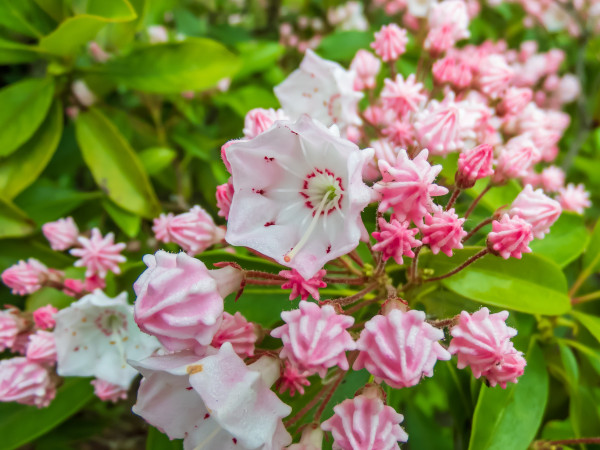
Zantedeschia is a genus of flowering plants from the family Araceae and is native to southern Africa. With a rich history dating back to the Ancient Romans, these deciduous or semi-evergreen perennials have been used as a symbol of celebration. Zantedeschia was Named after Professor Giovanni Zantedeschia, an Italian botanist.
There are two main forms of Zantedeschia: hardy and tender. Hardy forms of the plant can be grown outdoors, enjoy moist soil and full sun or partially shaded conditions - these are known as Arum lilies. Tender forms of Zantedeschia prefer being grown in containers or pots and should be brought inside over the winter - these are known as Calla lilies.
With tuberous flora in all colours from whites, yellows and oranges to deep reds and purples, Zantedeschias are not to be overlooked in any garden, as long as they have sufficient sunlight to grow in.
Ready to learn more about growing Zantedeschia? Read on for all there is to know...

Key Information
Soil pH
Position
Hardiness

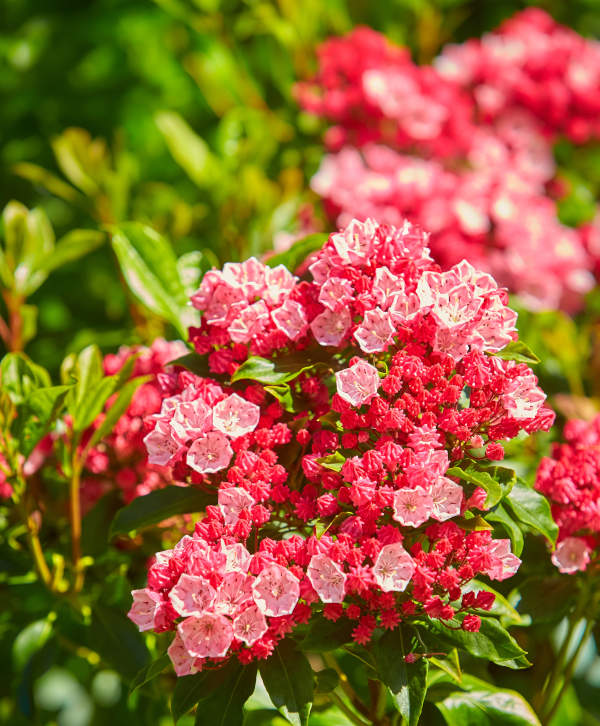
Where & when to plant Kalmia
Horticultural Divisions -
Here we list out the most popularly cultivated species available in the U.K.
| Species | Common name |
Hardy through most of the UK H4 (-10°C to -5°C) | Kalmia buxifolia | Sand myrtle |
Hardy in most places throughout the UK even in severe winters H5 (-15°C to -10°C) | Kalmia angustifolia | Sheep laurel |
Hardy in all of UK and northern Europe H6 ( -20°C to -15°C)
| Kalmia latifolia | Mountain laurel |
Kalmia polifolia | Calico bush | |
Kalmia procumbens | Alpine azalea |
Position - Part Sun/ dappled shade in sheltered or exposed locations. Will cope with full sun if soil is moist.
Soil - Moist drained soil which can be clay, loam or sand and prefers acidic to neutral soils.
Flower - Spring to summer.
Kalmias can be planted all year around when purchased grown in pots. Avoid planting out into water logged or frozen soil.
If container grown plants are planted out during the active summer growing season make sure that they are watered regularly until the plant has settled into its new location. Water at soil level rather than the foliage.
Kalimeris are ideal in cottage garden schemes, low maintenance gardens, banks and slopes, wildlife gardens, flower beds and borders.
How to plant Kalmia
- For planting in the garden, check your soil pH is suitable for growing this acid soil plant. If you grow heathers, azaleas and rhododendrons that your soil should be suitable.
- Dig the soil area removing any large stones and weeds and breaking up any lumps. Mix in some organic matter, ideally leaf mould, though manure or garden compost are also fine. Rake level and firm with your heels. Rake level again.
- To help acidify your soil, a good tip would be to mix some ericaceous compost and ericaceous feed into the planting hole and the excavated soil.
- Water plants well and allow to drain before planting.
- A good tip is to dig a hole twice the size of the root-ball. Fill with water and allow to drain before placing in the plant which is especially good for summer plantings.
- Remove the plant from its pot placing the plant in the hole, ensuring the top of the root ball sits level with the surface of the soil. Too low and the plant may rot, too high and the roots can dry out.
- Backfill with soil and firm in gently with your foot.
- Soak soil well with water.
- For planting in containers, first choose an appropriately sized pot around 5-7cm larger than the root ball of your plant (you’ll need to gradually increase the pot size every few years). Always ensure there are plenty of drainage holes in the bottom.
- Use a good quality ericaceous potting compost if you have it and mix with garden soil. Mix in some horticultural grit and, if not already present (check the labelling on the bag) some slow-release ericaceous fertiliser granules.
- Start by partially filling the pot with ericaceous compost; enough so that when placed on it the upper surface of the root ball is about 3cm lower than the top of the pot.
- Fill around the plant with compost, firming down with your fingers then adding a little more so it is held tight.
- Pick up the container and lightly tap on the potting bench or ground a few times to help further settle the compost around the plant.
- Soak well with water.
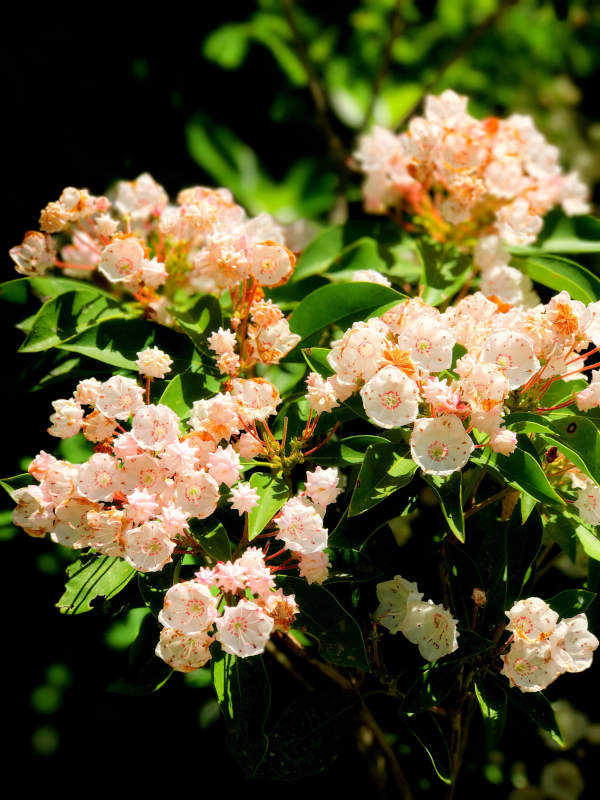
What to plant with Kalmia
Outdoors, plant alongside plants with different shaped or coloured foliage as a contrast whilst also making sure nearby plants have interest when kalmia does not.
Try plants such as Anemone, Azalea, Camellia, Echinacea, Gardenia, Hydrangea, Liriope, Magnolia, Rhododendron and Viburnum.
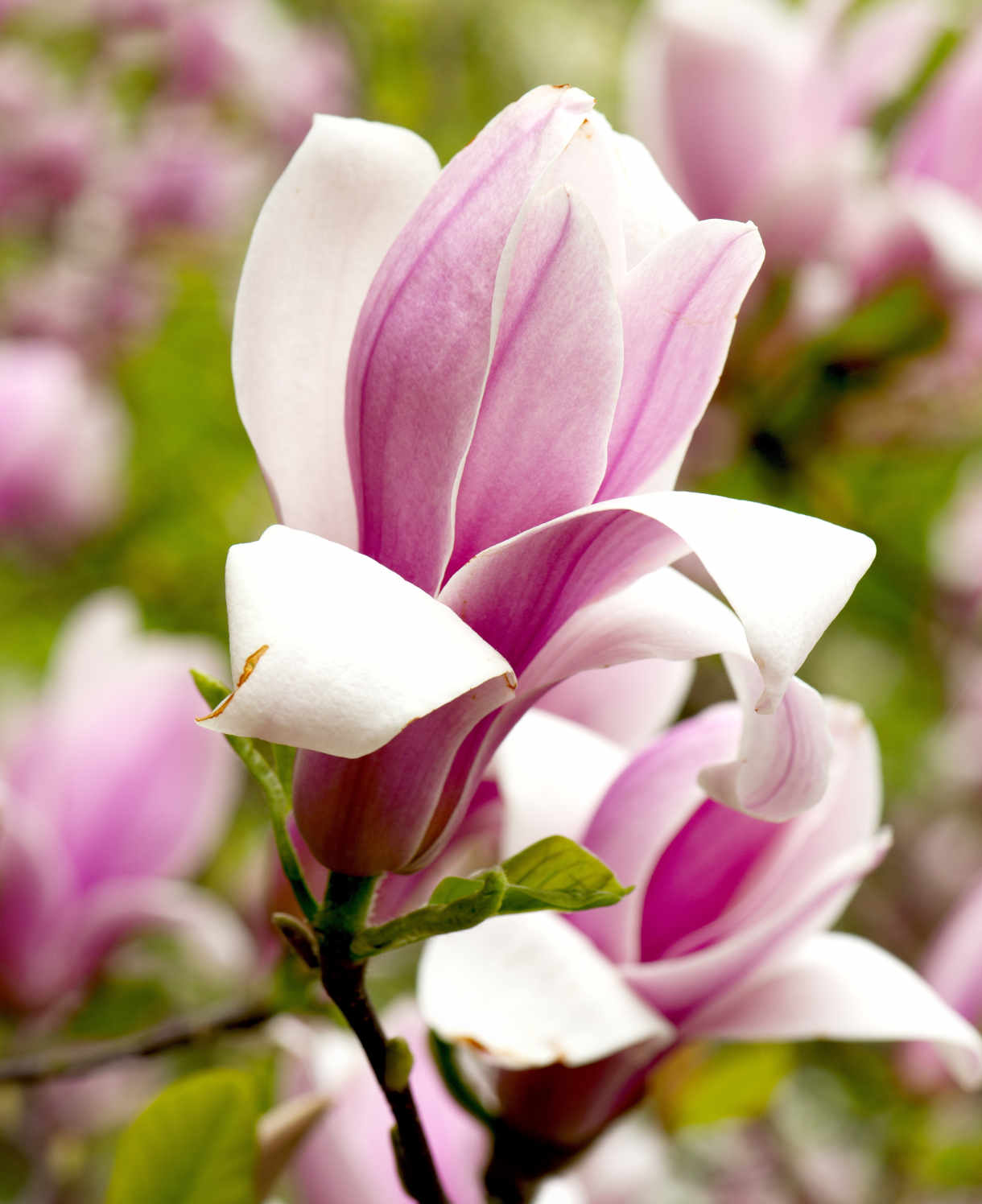

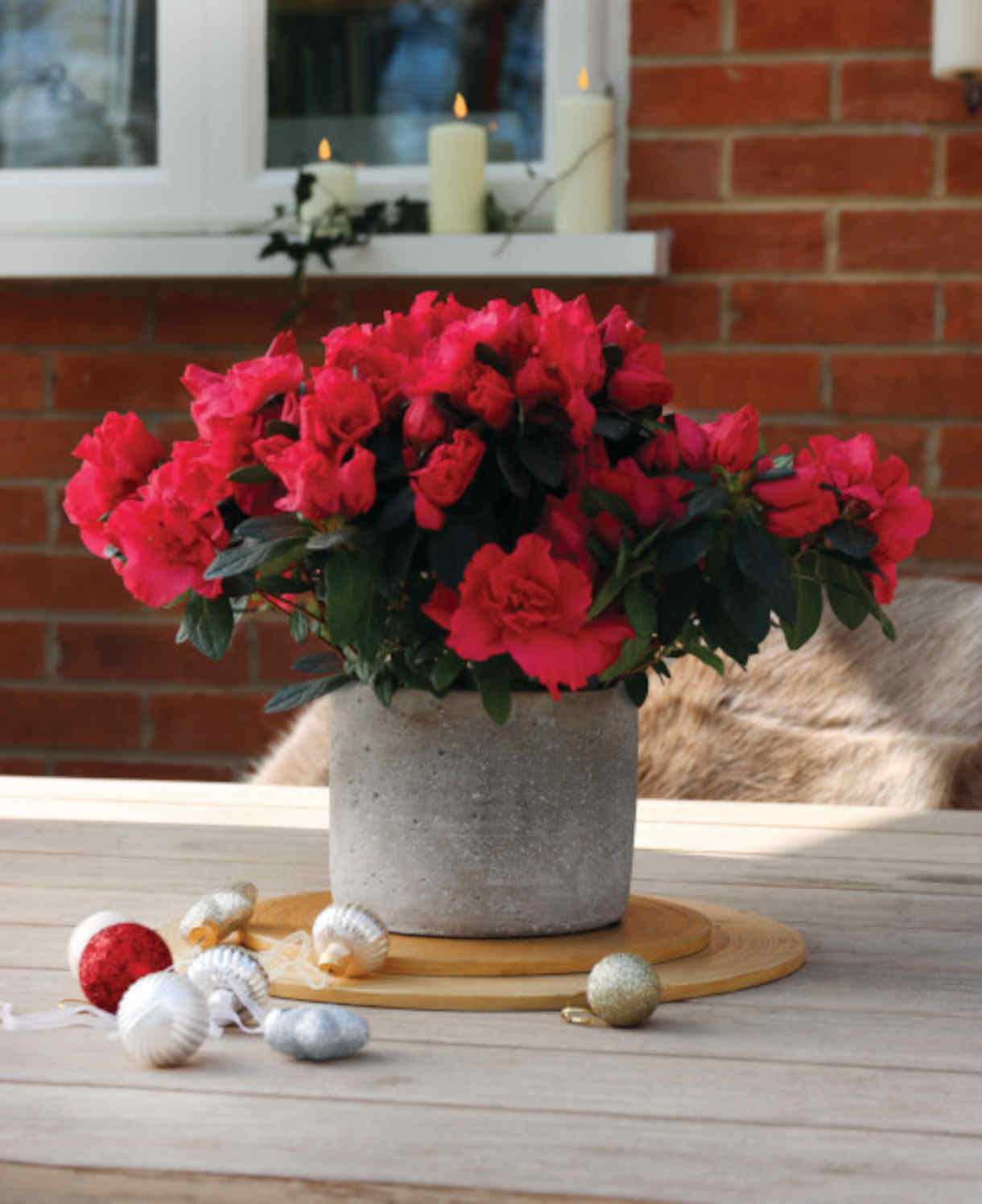
How to care for Kalmia
Pruning and Deadheading
Remove spent flower clusters after blooming has finished by trimming back to the main stem that they’ve grown from.
Kalmia fall into RHS Pruning Group 8. They require very little pruning. If required, after flowering to tidy the shape of the plant lightly cut back stems to an outward facing bud. Prune out any diseased or damaged stems.
*wear gloves and eye protection as sap can irritate skin.
Watering
On planting outside, they benefit from a good watering in on planting and then regular soakings until established. After this unless there is prolonged season of dry weather they should not need watering.
If grown in containers water the soil regularly checking the compost to see if the soil is dry when you wiggle your fingertip into the soil surface.
Feeding
On healthy, fertile soil, a mulch of well-rotted organic matter (i.e., a layer of leaf mould, manure, or garden compost applied to the soil around the plant) should provide enough nutrients for your kalimeris. This has the added benefit of suppressing weeds and locking in moisture. Mulch when planting, and then again each spring.
If you garden on poor soil or your kalmia looks in need of a boost, applying an ericaceous feed to the surface of the soil and lightly working in can reap benefits. This is known as a top dress and should be done when you’re mulching in spring – first apply the feed, then cover with the mulch.
Container-grown plants are different as they rely solely on the gardener for nutrition. Get off to a flying start by making sure you use a good quality ericaceous compost with slow-release granules mixed in. These generally provide nutrients for around 6 to 8 weeks, after which you’ll need to apply a suitable ericaceous liquid feed every 2-3 weeks until the end of the growing season (i.e., September-ish).
Remember to repot your kalmia every few years into a slightly larger pot using fresh ericaceous compost. In-between, it’s worth removing the top few centimetres of compost each spring and replacing with a fresh mix of compost and ericaceous slow-release granules.
Cold Protection
Kalmia are winter tough plants so do not need any particular cold protection.
Pests and Diseases
Kalmia are generally pest free in the garden although can be susceptible to mealybugs and vine weevil.
How to propagate Kalmia
Kalmia can be propagated by semi ripe cuttings.
Semi ripe cuttings are selected from this seasons growth in late summer or early autumn. The base of the cutting should be hard, while the tip is still soft and flexible.
- Its best to take cuttings in the morning to avoid wilt. Choose stems that look healthy and free of pest and disease.
- Choose a non flowering shoot which is approximately 10-15cm long from its tip.
- Using a sharp knife trim below a node (leaf joint) Remove the lower sets of leaves leaving 2 to 4 leaves at the top.
- Pinch out the soft tip to just above a leaf joint and dip the base into rooting hormone powder or liquid.
- Cut large leaved shrubs cut the leaf in half to reduce water loss.
- In a ready watered and drained pot level filled and lightly firmed with good quality ericaceous compost, make a hole for the cutting with a dibber. Insert the base of the cutting until the first set of leaves are just above the surface.
- In a 9cm pot you can put 3 cuttings in a triangular formation making sure the leaves are well within the edges of the pot.
- Cover with a plastic sandwich- like-bag to form a mini propagator is a good idea for the first few weeks. Hold the bag in place on the pot with an elastic band or string. Ensure the bag is stiff enough to hold upright above the plants foliage. The plastic bag holds in moisture keeping the humidity high which reduces the rate of water loss from the cutting, increasing the success rate of propagation.
- Place the pot on a saucer away from direct sunlight, yet in a light area that is around 18-24o
- At least twice a week remove the bag to allow some ventilation to the cuttings for 15 minutes. Check the soil surface feels damp.
- Rooting takes 2 to 4 weeks. Gently pull on one of the cuttings if it shows resistance then it is likely roots are forming. The bag can now be removed for longer periods of time gradually acclimatising the cuttings to their surroundings. (Hardening Off)
- Remove any dead or decaying material regularly. Increase ventilation to remove excess moisture.
- Once hardened off for 2 -4 weeks the cuttings should be ready for potting on individually. Carefully remove the plants from the pot as one root ball. Checking for signs of good rooting - if not ready leave to develop for few more weeks. Carefully separate each cutting ensuring a good portion of root is kept intact potting on into individual 9cm pots. Water well and leave to develop in a light sheltered environment until established.
* Many plants carry Plant Breeders Rights and cannot be propagated for commercial purposes.
Common Kalmia questions
Is kalmia hardy?
Yes kalmia is completely hardy in all UK gardens.
Is kalimeris poisonous to dogs?
Yes Kalmia is poisonous to dogs.
Should I deadhead kalmia?
Yes once the flowers have finished wearing gloves and suitable eye protection, cut flowering stems back to their growth pint on the stem.





